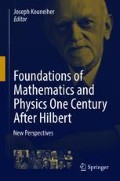Abstract
Highlights of the twenty-odd-year relationship between Einstein and Hilbert are reviewed. We trace the relationship between the two men during this period in the form of encounters, each of which characterizes a particular aspect of their relationship. We begin with the encounter that never took place (1912) when Einstein declined Hilbert’s invitation to Göttingen; the fateful encounter (1915–1916) leading to a dispute over the final formulation of general relativity; The tragic-comic encounter (1928–29) over editorship of the Annalen der Mathematik leading to what Einstein called “The battle of the Frogs and Mice”; L’envoi (1932) Einstein’s final letter of congratulations to Hilbert on his 70th birthday.
Access this chapter
Tax calculation will be finalised at checkout
Purchases are for personal use only
Notes
- 1.
The success of Einstein’s calculation was also based on his November 11 theory. The condition \(\sqrt{g} = -1\), implied by the assumption of an electromagnetic origin of matter, was essential for this calculation, which Einstein considered a striking confirmation of his audacious hypothesis on the constitution of matter, definitely favoring this theory over that of November 4. Thus when writing the Perihelion paper Einstein was still influenced by Hilbert’s electromagnetic theory of matter.
- 2.
The history of the long quest towards the final equations has been described by M. Janssen, J. Norton, J. Renn, T. Sauer and J. Stachel, all of whom have been part of the Einstein Papers Project editorial team. The winding story of the discovery of the Einstein Field Equations has recently been summarized by Janssen and Renn in an article for Physics Today.
- 3.
See his contribution to this volume.
- 4.
All Einstein documents mentioned in this article can be found in J. Stachel et al., eds., The Collected Papers of Albert Einstein, Princeton U. Press (1987). Hereafter we use the notation CPAE X; Y, with X the volume number and Y the document number.
- 5.
In 1912, Max Abraham had blamed Einstein’s theory of relativity and Einstein as well. Abraham thought that Einstein borrowed expressions from his new gravitation theory. On March 26, 1912, Einstein wrote to Michele Besso : “Abraham’s theory was created of the top of his head, i.e., from mere mathematical beauty considerations, torn off and completely untenable. In fact,“nostrification” was Einstein’s expression and not Abraham’s” [7]. That was almost Abraham’s opinion of Einstein’s theory, except for the mathematical beauty.
References
A. Einstein, Erklärung der Perihelbewegung des Merkur aus der allgemeinen Relativittstheorie. Königlich Preüische Akademie der Wissenschaften (Berlin, 1915c). Sitzungsberichte, pp. 831–839. 831
CPAE 5, The Collected Papers of Albert Einstein, vol. 5, ed. by M.J. Klein, A.J. Kox, R. Schulmann. The Swiss Years: Correspondence 1902–1914 (Princeton University Press, Princeton, 1993)
CPAE 8a, ibid., vol. 8, ed. by R. Schulmann, A.J. Kox, M. Janssen, J. Illy. The Berlin Years: Correspondence, 1914–1918, Part A 1914–1917 (Princeton University Press, Princeton, 1998)
L. Corry, David Hilbert and the Axiomatization of Physics, 1898–1918 (Kluwer, Dordrecht, 2004)
J. Renn, J. Stachel, Hilbert’s foundation of physics: from a theory of everything to a constituent of general relativity, in The Genesis of General Relativity, vol. 4, ed. by J. Renn, M. Schemmel. Gravitation in the Twighlight of Clasical Physics: The Promise of Mathematics (2007), pp. 857–973
J. Stachel, New light on the Einstein Hilbert priority question. J. Astrophys. Astron. 20, 91–101 (1999)
Einstein to Besso, March 26, 1912, CPAE 5, Doc. 377
Einstein to Zangger, November 26, 1915, CPAE 8, Doc. 152
G.-C. Rota, Indiscrete Thoughts (Birkhäuser, Boston/Basel/Berlin, 1997)
G. Chapman, Homer’s Batrachomyomachia, Hymns and Epigrams, 2nd ed., London: John Russell Smith 1888. Available online at https://ia700300.us.archive.org/29/items/homersbatrachomy00chapuoft/homersbatrachomy00chapuoft.pdf
W.P. van Stigt, Brouwer’s Intuitionist Program, in From: Brouwer to Hilbert/The Debate on the Foundations of Mathematics In the 1920s ed. by P. Mancosu (Oxford University Press 1988), pp. 1–22
W.P. van Stigt, The Brouwer-Hilbert controversy and the annalen affair, in Brouwer’s Intuitionism vol. 2 (1990), pp. 100–103
J. van Heijenoort, (2nd printing with corrections), From Frege to Gödel: A Source Book in Mathematical Logic, 18791931, (Harvard University Press, Cambridge Massachusetts, 1976); Brouwer, Intuitionistic reflections on formalism, in Philosophy of Mathematics: Selected Readings, ed. by H. Putnam, P. Benacerraf (Englewood Cliffs, N.J.: Prentice-Hall, 1964)
Author information
Authors and Affiliations
Corresponding author
Editor information
Editors and Affiliations
Rights and permissions
Copyright information
© 2018 Springer International Publishing AG, part of Springer Nature
About this chapter
Cite this chapter
Kouneiher, J., Stachel, J. (2018). Hilbert and Einstein. In: Kouneiher, J. (eds) Foundations of Mathematics and Physics One Century After Hilbert. Springer, Cham. https://doi.org/10.1007/978-3-319-64813-2_3
Download citation
DOI: https://doi.org/10.1007/978-3-319-64813-2_3
Published:
Publisher Name: Springer, Cham
Print ISBN: 978-3-319-64812-5
Online ISBN: 978-3-319-64813-2
eBook Packages: Physics and AstronomyPhysics and Astronomy (R0)

